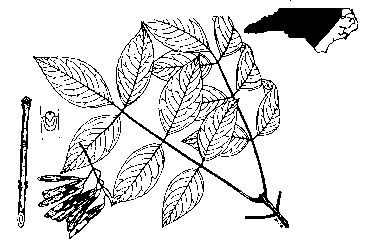|
White
Ash
(Fraxinus
americana L.)
|
|
| |
 |
|
| |
White
ash is found throughout the state except in the lower coastal
areas. It grows best in the rich moist soils of mountains coves
and river bottomlands. In the east, it grows with swamp chestnut,
willow, cherrybark oak, loblolly pine and sweetgum. In the west,
it grows with yellow poplar, black cherry, basswood, oaks and
extends into the beech -birch-maple forests at elevations of 4,000
to 5,000 feet.
The leaves are 8 to 12 inches long, opposite, with five to nine
(usually seven) oblong leaflets, 3 to 5 inches long, that have
smooth or finely toothed margins. Upper surfaces of leaves are
dark green and smooth; undersides are pale light green to whitish.
White ash twigs are stout, somewhat flattened at the point of
leaf origin. The leaf scars are broadly crescent shaped to semi-oval,
with a distinct notch in the upper margin that contains the leaf
bud. The dioecious flowers (male flowers occurring on one tree,
female flowers on another) grow in compact panicles. They open
before the leaves in the late spring. The fruit is 1 to 2 inches
long and grows in crowded clusters 6 to 8 inches long.
The tree may grow to 120 feet but commonly is 70 to 80 feet tall,
with trunk diameters averaging 2 to 3 feet. The ashy gray to brown
bark is deeply divided by narrow ridges into net-like patterns.
The wood of the white ash is extremely valuable because of its
toughness, elasticity and aesthetically pleasing grain. It is
preferred to all other native woods for small tool handles, agricultural
tools and athletic equipment such as baseball bats and oars. It
also is used extensively for furniture and interior finish. |
|
|

